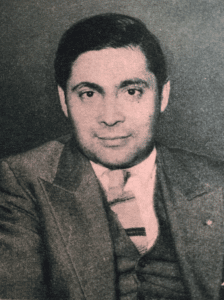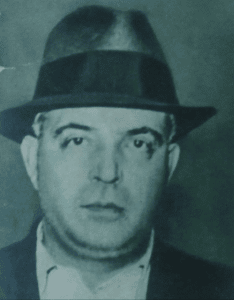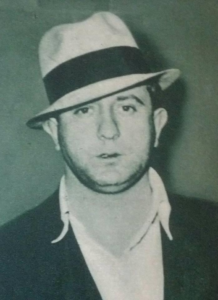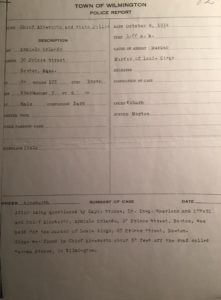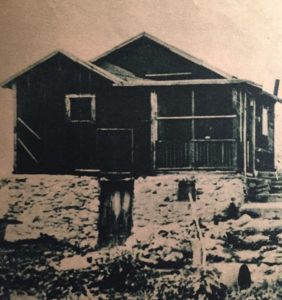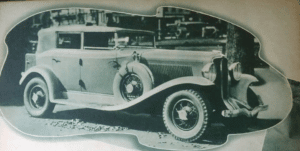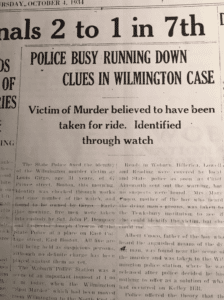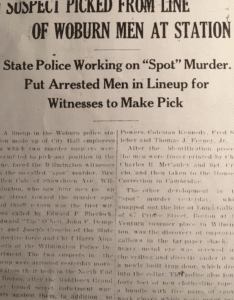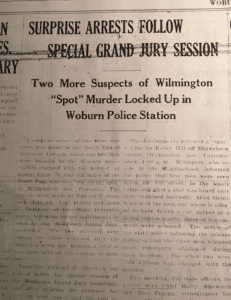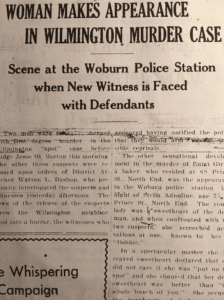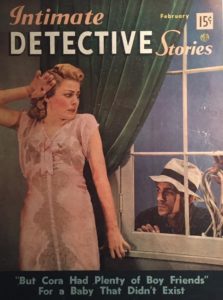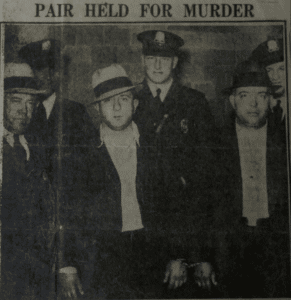
Dime store novels and newsstand crime magazines often featured the lurid and bawdy stories that were taboo to the respectable daily and Sunday broadsheets. Crimes of passion and of death and violence were the norm and the stories were so true. In one such instance, a tale of love and lust, torture, and murder made headlines in the local newspapers and on the pulp stock pages of a national true crime magazine. Featuring heavily in the story was Chief Harry Ainsworth and the officers of the Wilmington Police Department.
Kelley Hill, a small bump in the landscape as far as hills go, was so named for the Kelley Family that lived nearby on Shawsheen Avenue. Rising to about 170 feet above sea level, it was deemed a suitable site for a water standpipe when the town’s water department was founded in 1928. Six years later it was the site of a suspected gangland murder.
On October 3, 1934, at about 2:30 in the afternoon four men drove into Louis Elfman’s service station on Main Street. The driver bought gas and then asked Louis to check the brakes on the 1931 Auburn sedan. Louis was tied up with other work and told the men he could not address it right away, but the group seemed unruffled by the delay as they crossed the street and walked up over the Shawsheen Avenue Bridge. Louis, a little suspicious of the strangers, made a mental note of the license plate number. It was also the same car and license plate that had caught the eye of rookie Officer Burt Frotton a few moments earlier. On the job just two weeks, Burt Frotton was directing traffic in Wilmington Square when the fancy automobile full of strangers passed his post and pulled into Elfman’s service station. He jotted the license plate down in his notebook.
After leaving their automobile behind in the care of Elfman, the group of men walked along Shawsheen Avenue to Nassau Avenue and then to a ramshackle cabin on Kelley Hill owned by Orris Ventura of East Boston. The men presumably entered the cabin or were about to do so when gunfire rang out followed by screams that reverberated through the neighborhood. 17-year-old Gus Cuoco (grandfather of Wilmington Police Detective Brian Gillis) heard it as did a few women who lived nearby. It was Gus that found the reasoning behind the shots. Sprawled in the scrub brush near a tarpaper shack in the shadow of the standpipe was the bullet riddled body of Luigi Girgo. An immediate call went to the police station and Chief Harry Ainsworth, but the department’s lone cruiser was on the other side of town. Wasting no time, Chief Ainsworth commandeered the car of local resident Fred Mosher. “Take me up to Kelley Hill right away Fred” Ainsworth yelled as Wilmington News reporter Robert Pulsifer jumped in with them. Speeding up Main Street in Mosher’s car, the trio spied three men walking along the road. The Chief took note of their descriptions but continued along until he met up with Gus Cuoco who directed him to the victim’s location. Chief Ainsworth examined the barely breathing Girgo and sent Pulsifer and Mosher to the fire house to get the police ambulance. A fractured skull and bullet wounds to the back and head made it obvious to Chief Ainsworth that Louis Girgo had been mortally wounded. After reaching the firehouse, Pulsifer ran to the police station to call the state police while Norman Rice and John Howe (a Kelley Hill resident who had accompanied Pulsifer and Mosher) drove the ambulance back to Kelley Hill. Upon reaching the scene of the crime, the victim was speedily removed to the Tewksbury Infirmary where he later succumbed to his wounds.
In the meantime, Louis Elfman saw the return of not four men but only one. Not having yet checked the Auburn’s brakes, the mechanic was perplexed as the man brushed passed him and retrieved the automobile, quickly speeding away, south on Main Street. Elfman later saw the sedan with its lone occupant driving back and forth along Main Street. Elfman, however, never again saw the other men that had originally arrived at his station that afternoon.
As Pulsifer took control of the telephone at the police station and Howe and Rice brought Girgo to the state hospital, Chief Ainsworth began his canvass of the Kelley Hill neighborhood. Gus Cuoco’s mother was able to identify one the men as having frequented Orris Ventura’s cabin on the hill. Several other neighbors gave testimony as either having seen the men walking up the hill or as having heard gunshots and screams. Other testimony had shown that an additional two men may have also walked up to the cabin as well. Soon state police detail under the direction of Corporal Ford arrived to assist Chief Ainsworth. A gold watch was soon found amongst the grass and leaves about halfway between the cabin and where Girgo was found. It was believed to be the victim’s, unintentionally dropped as he fled his attackers. At the state hospital Louis Girgo was found to have been shot in the right temple with the bullet exiting through his left eye. Another gunshot wound was found in his back and there was a crushing traumatic injury to his skull over his right ear thought to have been inflicted by a blackjack or other similar weapon.
State detectives and an assistant district attorney lent their expertise to the case and soon Chief Ainsworth and State Police Inspectors Sherlock and O’Neil were talking to both Louis Elfman and Officer Frotton. Louis Elfman’s mental note of the Auburn’s license plate was 704754 while Officer Frotton’s notebook indicated that the plate number was 704745. After a check of both plates, it was found that 704745 was the correct number as it belonged on a 1931 Auburn sedan, the suspect vehicle described by both Elfman and Frotton. The vehicle was registered to Arniello Orlando of 90 Prince Street in Boston’s North End. Meanwhile, back on Kelley Hill, Chief Ainsworth and Inspectors Sherlock and O’Neil made a gruesome discovery in Orris Ventura’s cabin. In the sparse interior several pairs of cotton gloves and a set of heavy industrial pincers were found laid out on a table. Above, hanging from a rafter was a hangman’s noose. The officers speculated a torturous end had been in store for Louis Girgo. They also speculated that having been enticed to the cabin and soon discovering what awaited him, he fled. The bludgeon and gunshots being the alternative to the original plan.
As evening fell, the suspected getaway car was discovered in a commercial garage in the North End. In the rear seat a set of heavy brass knuckles, quickly confiscated as the possible weapon used to crush Girgo’s skull. Further investigation revealed that the owner of the was friends with Julio Ventura, the brother of Orris Ventura. Later on, that evening, Chief Ainsworth, State Police and Boston Police raided an apartment in East Boston. Waiting outside for their opportunity, the police officers overheard a conversation (in Italian) amongst several occupants of the apartment. They were discussing the crime. When police broke in one of the men said in Italian “Don’t say anything, they’ll never convict us. Unfortunately, one of the officers overhearing the pre-raid conversation spoke fluent Italian. The five men in the apartment, Julio Ventura, Arniello Orlando, James Penta, Angelo DeVito and Angelo Cadero were quickly arrested and hustled off to the Woburn Police Station for questioning, Wilmington’s small police station being inadequate for the task.
Julio Ventura’s and Arniello Orlando’s stories were full of contradictions and lies and they were held on first degree murder charges. The three remaining men were released but remained suspected accomplices. However, on October 9, 1934, just six days after the murder, a specially convened grand jury handed down indictments against all five. Penta and DeVito were quickly arrested in a pre-dawn raid in the North End shortly after the indictments had been unsealed but suspecting such a thing might take place, Angelo Cadero fled to places unknown.
Further questioning soon revealed a sordid love triangle wherein Louis Girgo had stolen Julio Ventura’s girl, Stella Andoline away from him. It was in fact Stella Andoline that confronted Ventura at the Woburn Police Station line-up stating that she knew they had killed Girgo. It was surmised that the five suspects intended to kidnap, torture and hang Girgo over his involvement Ventura’s girl. After all it was not about liquor or the rackets as initially suspected.
In 1936, the fifth suspect, Angelo Cadero was apprehended in the Midwest having been on the lam since the murder. That year Chief Ainsworth and Detective Lieutenant Dempsey of the State Police traveled to Fond du Lac, Wisconsin to bring the fifth and final suspect back to Massachusetts to stand trial.
In 1939 Chief Ainsworth and the Kelley Hill Murder Case were featured in Intimate Detective magazine.
